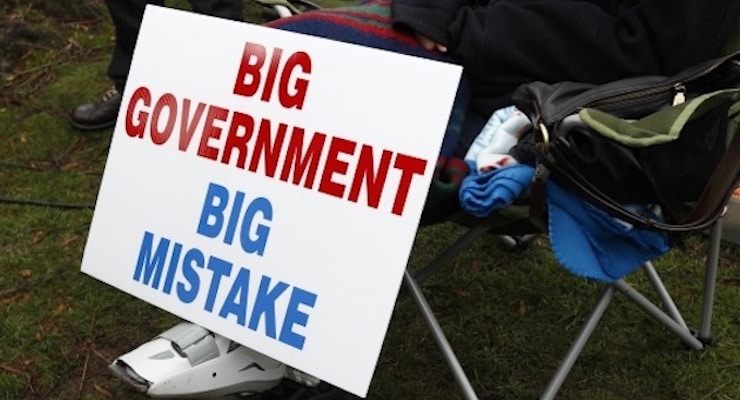

A protestor rests next to their big government big mistake sign. (Photo: Reuters)
Which states in our union are the most tolerant of marijuana and guns? Which interfere the least with your life? Which are likelier to hand out special goodies to politically connected companies? Those are some of the questions answered by economists Will Ruger and Jason Sorens in the 2016 edition of their study “Freedom in the 50 States.”
Their ranking of the states in the U.S. in terms of freedom is based on three public policy dimensions affecting economic, social and personal freedoms. Sorens, a lecturer in the government department at Dartmouth College, and Ruger, vice president of research and policy at the Charles Koch Institute, scored more than 200 policies, including things such as gambling restriction, trans fat bans, the audio recording of police, occupational licensing restrictions, mandated family leave and the ability of couples to enter into private contracts.
According to their open-source methodology, in 2014 the freest states were New Hampshire, Alaska and Oklahoma, while New York, California and Hawaii ranked the least free. In terms of just one indicator, South Dakota, Idaho and Tennessee are the freest economically and New York, California and Hawaii the least. And personal freedoms are best served in New Mexico, Colorado and Nevada, with Kentucky, Texas and Alabama ranking the least free.
It’s valuable to know how free your state is. I, for instance, value freedom for its own sake, so I’m interested in knowing that Virginia, where I live with my two school-age daughters, ranks 21st in the overall index. I also enjoy knowing that the state isn’t too bad on fiscal issues, that its land use freedom is decent, that it has no minimum wage, that it’s one of the best states for gun laws, that it has too many government employees and that it’s in serious need of criminal justice reform because it has one of the highest incarceration rates in the country, even controlling for crime rates.
The rankings also deliver important lessons for lawmakers. In Virginia, Sorens and Ruger write, “victimless crime arrest rates are about average. Asset forfeiture is virtually unreformed, and local police frequently circumvent it anyway with equitable sharing. The state’s approach to cannabis producers and consumers is draconian.” They suggest that the state reform “sentencing for nonviolent offenses with an eye to reducing the incarceration rate to the national average in the long term.”
The report shows that when controlling for climate and other variables, all three dimensions of freedom are positively correlated to migration, but the results are exceptionally strong for economic (fiscal and regulatory) freedom. Edition after edition of the “Freedom in the 50 States” index confirms that people tend to move to economically freer states because economic freedom tends to be a fairly good indicator of prosperity. More economic growth usually means more jobs, and that attracts people.
The lesson for lawmakers is that if you want to attract productive people to your state or if you want to lose fewer productive taxpayers, you’d better implement policies that trigger economic growth and create jobs. In 2014, New York’s net migration was negative 11.2 percent. California was negative 4.9 percent, and Hawaii was negative 3.3 percent.
That raises the question of why so many people still live in the least free states. The fact is that when it comes to where people choose to live, intrinsic characteristics of a state weigh heavily in the decision. Among the factors that keep people in less-than-free places are jobs, family, friends and city amenities. There’s a certain stickiness to states that has nothing to do with how free these places are.
The federal tax and regulatory systems are incredibly burdensome and can weigh on us all more than most state policies, which can hinder interstate mobility. However, there are times when that stickiness isn’t so important — for example, when you are younger, are looking for a job and haven’t settled anywhere yet or when you’re about to retire. (Net migration in Florida was 10 percent in 2014.)
The bottom line is — whether you value freedom intrinsically or you’re a lawmaker who wants to improve your state’s economic outlook or slow down out-migration — you’re better off knowing where your state stands so you know what to do. “Freedom in the 50 States” will help you achieve this goal.






